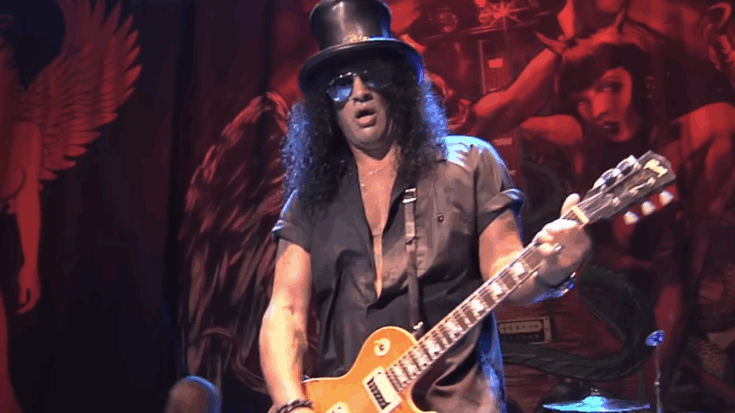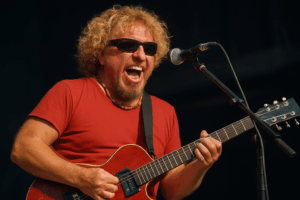Near-Death Moments That Almost Ended Rock History

via Moshcam / YouTube
The history of rock is littered with close calls that could have rewritten everything fans take for granted today. Behind the loud guitars and the swagger are lives pushed to extremes, where touring schedules, substances, and relentless pressure collide in ways few industries can match. For every legend who didn’t make it, there are musicians who somehow slipped past fate at the last second, often with stories that sound too wild to be true until you check the facts.
These near-fatal episodes weren’t always dramatic plane crashes or headline-grabbing overdoses. Some were the result of chaotic decisions on the road, others from private battles with addiction that nearly ended careers before they fully bloomed. A handful involved moments so sudden and violent that surviving them feels like a small miracle. Yet each close brush highlights how thin the line is between mythmaking and tragedy in a genre built on excess.
What makes these stories stand out isn’t just the danger; it’s the aftermath. The artists who lived through these moments didn’t return unchanged. Many came back with a sharper sense of purpose, a new chapter in their sound, or a deeper understanding of the cost of surviving the lifestyle they once embraced without hesitation. These near-death moments didn’t just shape personal lives—they nudged rock history itself into the form we know today.
1. Mötley Crüe’s Chaos Hit a Breaking Point When Nikki Sixx Briefly Lost His Life
At the peak of their late-’80s dominance, Mötley Crüe were riding a wave that looked unstoppable. Stadiums were packed, Girls, Girls, Girls was selling in the millions, and their reputation for excess had become as iconic as their riffs. But behind the makeup and the motorcycles, the band’s inner world was buckling under the weight of addiction and momentum they couldn’t slow down.
Nikki Sixx had been spiraling for months, hiding a heroin problem that had grown far darker than anything fans saw in the press. That December in Los Angeles, after hours of partying with members of Guns N’ Roses, his legendary overdose brought everything crashing down. Paramedics revived him with adrenaline shots, a moment that later fueled one of the Crüe’s most recognizable anthems.
The incident didn’t just shake him—it rattled the entire band. Tour dates continued, the image remained loud and invincible, but the illusion of control had shattered. Sixx’s brush with death became one of the most infamous turning points of the era, a moment that exposed the cost of keeping up a larger-than-life persona when the backstage reality was falling apart.
2. Travis Barker’s Plane Crash Turned a Routine Flight Into a Fight for Survival
Travis Barker’s life changed in seconds when a private jet meant for a quick trip home became a fireball at the end of a runway. Mechanical failure sent the aircraft skidding through barriers and across a road before it erupted in flames. Four people died instantly. Barker and Adam “DJ AM” Goldstein were the only survivors.
The drummer escaped with severe burns across much of his body, later describing how he panicked his way straight into a pool of jet fuel as he tried to get out. The physical injuries were immense, but the mental aftermath proved just as heavy. For years, he refused to set foot on a plane, even if it meant backing out of overseas tours.
His recovery stretched far beyond hospital rooms and skin grafts. Relearning to navigate life without constant fear took years, and only recently has he been willing to fly again when work demands it. The crash didn’t just pause his career—it redefined his relationship with risk, touring, and what it meant to survive something few ever walk away from.
3. Slash’s Overdose Nearly Cut the ‘Use Your Illusion’ Tour Short
Guns N’ Roses built their legacy on turbulence, and no one embodied that volatility more than Slash during the early ’90s. The band was one of the biggest acts on the planet, but their success came wrapped in a level of excess that left almost every member battling something destructive. For Slash, heroin became the shadow trailing him from city to city.
During a tour stop in San Francisco, his habit nearly killed him. After locking himself away with a dealer’s full stash, he wandered into a hotel hallway, collapsed, and flatlined. Paramedics managed to revive him, a moment he has spoken about with startling clarity despite the chaos surrounding it.
Most bands would halt everything after a near-death event. Guns N’ Roses were not most bands. Slash checked himself out of the hospital and rejoined the tour like nothing had happened, carrying on with shows that were already infamous for their unpredictability. The episode became another chapter in a long list of close calls that could have ended one of rock’s biggest acts overnight.
4. Josh Homme’s Routine Surgery Turned Into a Life-Threatening Ordeal
Life-threatening experiences in rock often come from reckless living, but Josh Homme’s near-death moment didn’t begin with a backstage party or a torn-up tour schedule—it started with a knee operation. What should have been an easy procedure spiraled out of control when complications set in, leaving him clinically dead on the table before doctors pulled him back.
Survival was only the start of a long, painful recovery. He spent months confined to a room, battling infections, tubes, and a level of immobility he wasn’t prepared for. The physical suffering was intense, but the emotional aftermath lingered longer than any medical complication.
Homme has been candid about how the experience shook his sense of purpose. It stripped away noise, ego, and distractions, leaving him with a sharpened view of what mattered. That clarity reshaped him as a person and a bandleader, turning a terrifying medical emergency into one of the most defining resets of his life.
5. Taylor Hawkins’ Overdose Nearly Ended the Foo Fighters Before Their Prime
When Taylor Hawkins overdosed in 2001, the Foo Fighters were still solidifying their identity as one of rock’s most dependable touring bands. Hawkins had only been with the group for a few years, but his energy and chemistry with Dave Grohl had transformed the lineup. His sudden collapse and two-week coma sent shockwaves through the band and their future plans.
The drummer later spoke openly about that period, admitting that a year of heavy partying spiraled into something he hadn’t fully recognized as dangerous until it was too late. The overdose became a frightening wake-up call—one that forced everyone around him to confront how fragile the band’s momentum really was.
What followed could have fractured the Foo Fighters completely. Grohl briefly stepped away to work with Queens of the Stone Age, and Hawkins believed the band was over. Instead, both men returned stronger, cementing a partnership that carried them for two more decades. Hawkins’ survival didn’t erase the damage, but it gave the band a second chance—one that shaped their path until his death in 2022.
6. James Hetfield’s Pyro Accident Sparked One of Rock’s Most Infamous Stadium Riots
Metallica joining forces with Guns N’ Roses in 1992 should have been a victory lap for two of the decade’s biggest acts. Stadiums were selling out, demand was enormous, and both bands were pushing their shows to theatrical extremes. But what looked like a rock fan’s dream pairing quickly spiraled into a logistical and emotional circus behind the scenes.
During a Montreal stop on August 8, things collapsed in seconds. James Hetfield, disoriented while navigating the stage during “Fade to Black,” stepped directly into a pyrotechnic blast meant for a later cue. Flames shot up under him, leaving him with severe burns as crew members scrambled to drag him offstage and rush him to the hospital. Metallica’s set ended on the spot, leaving the audience stunned and restless.
Promoters begged Guns N’ Roses to start early to keep the night alive, but the situation only deteriorated. After walking on late and walking off early—citing technical issues—Axl Rose triggered a crowd eruption that turned into a full-scale riot. What should have been a blockbuster co-headlining tour instead became a cautionary tale about ego, pressure, and sheer unpredictability at the height of rock’s stadium era.
7. Phil Anselmo’s Post-Show Ritual Sent Him Into Cardiac Arrest
Pantera built their legacy on grit, groove, and an intensity that carried American metal through a decade when the genre was fading from the mainstream. But the same drive that kept the band alive pushed frontman Phil Anselmo into patterns that were far more dangerous than fans realized at the time. Chronic back pain, relentless touring, and a dependency on heroin created a cycle he struggled to break.
After a 1996 show in Dallas, Anselmo’s nightly routine took a disastrous turn. He injected a dose that immediately sent him into cardiac arrest, leaving him technically dead for several minutes before medical teams revived him. Days later, he stood before reporters and spoke bluntly about what happened, refusing to downplay the severity of the overdose or the reality of his addiction.
His struggles didn’t end that night, but the event marked a turning point. Years later, when he finally stepped away long enough to undergo proper back surgery, he forced himself to detox beforehand—an ordeal he openly described as brutal but necessary. The same pain that fueled the addiction eventually pushed him toward recovery, creating one of the most complicated redemption arcs in modern metal.
8. Ozzy Osbourne’s ATV Crash Nearly Ended the Prince of Darkness Era
Ozzy Osbourne spent decades surviving the kind of chaos that would have ended most musicians’ careers before they started. But in 2003, the scare that almost stopped him came not from a stage stunt or a night of excess, but from a simple ATV ride on his English estate. At 55, Ozzy had already weathered countless self-inflicted disasters, yet this one blindsided everyone.
The crash left him with a broken collarbone, a damaged vertebra, and eight fractured ribs severe enough to pinch vital blood vessels. He was rushed into intensive surgery to stabilize the injuries, while his family waited through hours of uncertainty. Jack Osbourne later listed the damage in a way that made the incident sound more like a high-speed collision on tour than a backyard accident.
Recovery brought its own fallout. The painkillers he relied on during rehabilitation affected his behavior on The Osbournes, blurring the line between reality TV antics and genuine medical aftermath. Even so, he eventually rebounded and returned to work, adding two more decades to a career that seemed unkillable. Ozzy ultimately passed in 2025, but the ATV crash remains one of the closest calls in a life full of them.
9. Rick Allen’s Car Crash Took His Arm—But Not His Place in Def Leppard
Rick Allen’s story is woven into Def Leppard’s identity just as much as their arena-shaking hits. Before he became the band’s symbol of perseverance, he was a 21-year-old drummer driving through Sheffield on New Year’s Eve in 1984 when his Corvette spun out of control. The car vaulted into a nearby field, throwing Allen from the seat and severing his left arm in the crash.
Doctors initially reattached the limb, but complications soon forced a full amputation. For most musicians, losing an arm would have meant the end of a career built on rhythm and precision. Allen’s future seemed impossibly uncertain while his bandmates watched and waited, unsure whether the group could stay intact without the drummer who had been with them since his teens.
Instead of stepping down, Allen pushed himself into uncharted territory. With engineers, he designed a custom drum kit that rerouted left-arm responsibilities to his left foot, then rebuilt his technique from the ground up. By the time Hysteria was released in 1987, he had redefined what was physically possible for a rock drummer. His comeback wasn’t just inspiring—it helped anchor one of the biggest albums of the decade.
10. Scott Stapp’s 14-Story Suicide Attempt Nearly Ended Creed Before Their Reunion Years
Well before Scott Stapp’s public unraveling in 2014, he had endured a terrifying brush with death that almost erased Creed’s frontman long before his redemption arc began. The incident happened in the early 2000s, when substance use and untreated mental health issues began distorting his grasp on reality. Behind the scenes, he was spiraling far faster than fans realized.
Rapper T.I. later recounted how he heard faint groaning from a balcony one night and discovered a severely injured man clinging to the rail after a failed suicide attempt. The fall from the 14th floor was broken only by a ledge several stories below—an impact that should have been fatal. When T.I. spoke to him, Stapp was disoriented, rambling, and convinced he had been betrayed by people close to him.
The rapper coaxed him away from the edge and got him help, ending a moment that could have closed the book on Creed long before their eventual reunions. Stapp’s later breakdown in 2014 grabbed headlines, but the balcony incident was the moment that nearly silenced him for good. Surviving it set the stage for years of slow rebuilding, treatment, and a push toward sobriety that eventually stabilized his life and career.
11. Bret Michaels’ Ferrari Crash Marked the End of His Hard-Partying Run
Bret Michaels had kept the party going long after Poison’s chart-topping days faded, convincing himself the late ’80s momentum still had fuel left in it. By 1994, the glam metal wave had already crashed, but his lifestyle hadn’t slowed. That illusion shattered the night he lost control of his Ferrari and slammed it into a telephone pole, turning a fast drive into a near-fatal wreck.
The impact left him with a laundry list of injuries: a broken jaw, shattered nose, fractured ribs, and damaged fingers. He later admitted he had been racing between parties when the crash happened, grateful only that no one else was hurt. It became one of the clearest signs that the decade’s culture of excess had trailed some of its stars well into an era where the world had moved on.
More than twenty years later, he found himself in another accident—this time rear-ending a woman in Arizona. No one was injured, but the moment served as an echo of the past. By then, Michaels wasn’t the unbreakable glam icon anymore; he was a survivor who’d already tested fate more than once and knew how close he came to losing everything.
12. Bill Berry’s Onstage Aneurysm Nearly Halted R.E.M.’s ‘Monster’ Tour
R.E.M.’s massive Monster tour was already straining the band physically and mentally when disaster struck in Switzerland. Midway through the set, drummer Bill Berry felt a sudden burst of pain behind his eye—sharp, unfamiliar, and impossible to ignore. He kept playing through the final measures of “Tongue,” determined not to cause chaos in front of thousands, even as the room began to tilt around him.
Moments after stepping backstage, he collapsed. The crew scrambled, the band panicked, and the audience waited for answers. Fortunately, Joey Peters from the opening act stepped in to finish the show, preventing the night from unraveling into confusion or fear. Behind the curtain, Berry’s condition turned out to be far more serious than anyone imagined.
Swiss doctors—some of the best specialists in neurosurgery—determined he’d suffered a life-threatening aneurysm and discovered another that could rupture at any moment. A craniotomy saved him, and within days, he was awake and recovering. But the episode revealed how fast a high-pressure tour could take down even a seasoned veteran, turning a global victory lap into one of the band’s most sobering chapters.
13. Jonathan Davis Faced Life-Threatening Health Crises From Childhood to Korn’s Peak
Jonathan Davis’ connection to hospitals dates back long before Korn ever existed. As a child, he suffered from severe asthma attacks that repeatedly pushed him to the edge of survival. Emergency rooms were a familiar sight, and he grew up knowing that simply making it to adulthood wasn’t guaranteed. Years later, those early struggles would echo back at him at the height of his fame.
In the early 2000s, Korn were selling millions of albums and touring the world when Davis suddenly began feeling unusually weak, bruised, and exhausted. A doctor’s visit in London turned into an emergency hospitalization once test results revealed dangerously low platelet counts. The diagnosis—immune thrombocytopenic purpura—meant that even headbanging onstage could trigger a fatal brain bleed.
The illness forced him to cancel performances and face the possibility that his career could end overnight. Davis later explained that the entire crisis had been triggered by an allergic reaction to medication, a small cause with terrifying consequences. The scare added another layer to his already complicated history with health, proving that even at the height of success, he remained vulnerable to the same fragility he battled as a kid.
14. Alice Cooper’s Hanging Stunt Nearly Turned Deadly at Wembley Stadium
Alice Cooper’s stagecraft has always blurred the line between theater and danger, built on the thrill of making audiences question whether they were watching a performance or something genuinely hazardous. For years, one of his most daring illusions was a mock hanging act involving a harness and a thick piano wire, choreographed to stop just inches above catastrophe.
At Wembley Stadium in 1988, the illusion malfunctioned in a way Cooper had never experienced in over a decade of performing the stunt. The wire snapped unexpectedly, sending the rig lurching downward with real force. Instinct saved him—he jerked his head back just in time to keep the noose from tightening around his neck, but the sudden drop knocked him unconscious and left him with a harsh rope burn.
The close call could have retired the trick forever, but Cooper bounced back with the same showman instinct that built his career. After recovering, he continued performing a redesigned, safer version of the stunt, refusing to abandon the theatrical edge that defined his persona. The Wembley accident became a stark reminder that behind every spectacle was a real human body absorbing the risk.
15. Eddie Vedder’s Dangerous Surf Rescue Was One of Several Near-Death Close Calls
Eddie Vedder had always been drawn to the ocean, often using surfing as a break from the pressures of touring. During a stop in New Zealand, he headed out with friend and songwriter Tim Finn, unaware of how treacherous the conditions were that day. A powerful riptide ripped him away from shore, dragging him nearly 250 feet into rough open water before he could react.
Volunteer lifeguards raced into action and pulled him back to safety before exhaustion took over. Vedder thanked them briefly, though the rescue team later admitted they expected something more substantial from a global rock star. Still, the incident left an imprint on Vedder, who had come frighteningly close to becoming another tragic headline.
It wasn’t his last close scrape. In 2001, a capsized boat off Maui left him and friends drifting until a passing vessel rescued them. Years later, he donated $70,000 to that same captain during a medical crisis. And in 2024, Pearl Jam themselves faced another near-fatal emergency tied to an undisclosed band illness that forced show cancellations. Each episode served as a reminder of how fragile even the strongest frontmen can be when nature—or health—turns unpredictable.
16. Ace Frehley’s Onstage Electrocution Nearly Ended His KISS Era Before It Began
Ace Frehley had already helped turn KISS into a force during the mid-’70s, but one night in Florida nearly cut his career short. During the Rock and Roll Over tour stop in Lakeland, he descended a metal staircase with his guitar in hand when a jolt of 220 volts shot through his body. The current hit him so hard that he fell backward off the steps, narrowly avoiding a far more catastrophic landing.
He later explained that the railing hadn’t been grounded properly—a technical oversight that nearly became a fatal one. Stunned and temporarily numb from the shock, Frehley spent several minutes recovering in the dressing room, unsure if he could lift his hand, let alone play. The crowd began chanting his name, and somehow, adrenaline carried him through the rest of the show.
Despite the scare, the experience didn’t drive him out of KISS. His eventual departure in the early ’80s had more to do with burnout and creative frustration than fear. The electrocution became another wild chapter in a band already defined by spectacle and danger, a reminder that behind the makeup and theatrics were real hazards lurking in the stage lights.
17. Ivan Moody’s Alcohol Withdrawal Left Him Unresponsive for Minutes
Ivan Moody’s battles with alcohol had long been visible to fans, but the full extent of the danger didn’t surface until he tried to quit drinking abruptly after years of constant benders. By 2013, his bandmates had warned him that his place in Five Finger Death Punch was at risk, and he eventually decided to clean up on his own terms. What he didn’t anticipate was how deadly withdrawal could be.
Moody locked himself in his home for several days, unaware that quitting cold turkey after extreme alcohol use can trigger seizures and cardiac failure. His body began to shut down, and at one point he became unresponsive for more than three minutes. The moment blurred the line between life and whatever he described as a strange “blue haze,” an experience he still struggles to put into words.
His daughter was the one who found him and called for help, a moment he credits as the reason he’s still alive. Emergency responders revived him with paddles, and the incident later inspired the music video for “The Tragic Truth.” As of 2025, Moody has been sober for seven years, carrying the memory of that near-fatal attempt as a reminder of how close he came to losing everything he built.
18. Brian Johnson Survived a Violent Racing Crash After Already Losing His Hearing to Speed
Brian Johnson’s retirement from AC/DC in 2016 was blamed on severe hearing issues, but he later revealed that the damage came not from decades on stage—but from sitting inside roaring race cars without proper protection. His love of motorsports had always run parallel to his music career, and in 2017, that passion nearly ended his life during a vintage race at Silverstone.
While driving a classic Austin A35 during the Celebrity Challenge Trophy, Johnson lost control and rolled the car completely. Photos of the wreck stunned fans: the crumpled vehicle looked impossible to survive. Yet he walked away with only minor injuries, helped by the safety gear and fast medical response waiting at the track.
It wasn’t even his first brush with vehicular disaster. Decades earlier, as a teenager, he had been trapped inside a burning car after a collision. He feared rescuers had abandoned him when they pulled his friend out first, but firefighters eventually dragged him free with burns on his hand. Between flames, rollovers, and roaring engines, Johnson’s life offstage has often been just as hazardous as anything he did under the lights.
19. Dave Grohl’s Santa Cruz Surf Scare Left Him Fighting Panic and the Pacific
Dave Grohl may be best known for drums, guitars, and stadium anthems, but surfing has always been one of his escapes from the pressure of fame. During a session in Santa Cruz, he paddled out with friends using a massive 14-foot longboard borrowed from someone’s father. The nostalgia of riding an old board quickly faded when the ocean turned hostile.
Without a leash to keep the board tethered, Grohl lost it against the cliffs and soon found himself hammered by relentless waves. Each one pushed him farther from control, and he realized the set wasn’t ending anytime soon. Panic crept in, and he later admitted that for several minutes, he was convinced he might drown before anyone noticed he was missing.
Instinct eventually took over. Instead of freezing, he began paddling steadily until he reached calmer water and could regroup. The ordeal became one of those private near-death moments rock stars rarely talk about, overshadowed by public achievements but deeply imprinted on the person who lived through it.
20. Eric Clapton Survived Ulcers and a Car Crash Within Days of Each Other
Eric Clapton’s early ’80s period was defined by substance abuse and personal turmoil, but few realized how close he came to dying in 1981. While touring the United States, he collapsed backstage in Wisconsin and was rushed to the hospital. Doctors discovered multiple bleeding ulcers, one of them dangerously close to rupturing near his pancreas—a scenario that could have killed him instantly.
The emergency treatment saved his life, but he barely had time to process what happened before fate struck again. Just days after being released, Clapton was involved in a serious car accident that left him bruised and battered, amplifying the wake-up call he’d just received. It seemed like two warnings delivered in rapid succession.
Although he vowed to cut back on alcohol and drugs, the promise didn’t stick immediately. He eventually checked into rehab the following year, finally choosing recovery over self-destruction. Looking back, Clapton has expressed more regret for the pain he caused others during that time than for the danger he put himself in. Surviving those two incidents marked the turning point that pushed him toward lasting sobriety.
21. Keith Richards’ Sacramento Electrocution Became One of His Most Dangerous Close Calls
Keith Richards has survived enough chaos to fill an entire book, but the electrocution he remembers most vividly happened during a Rolling Stones show in Sacramento in 1965. The band was in the middle of performing “The Last Time” when the neck of Richards’ guitar touched an ungrounded microphone. The surge blasted through him with such force that the crowd watched him fly backward across the stage.
Fans later recalled believing they had just witnessed his death. Richards regained consciousness in the hospital, overhearing a doctor casually remark, “Well, they either wake up or they don’t.” It became one of the earliest reminders that rock stages in the ’60s were held together with far less regulation—and far more danger—than anyone likes to remember.
The Sacramento incident was only one chapter in a life filled with unlikely escapes. Near-misses followed him through the decades, from almost being shot at Altamont to nodding off with a lit cigarette and narrowly avoiding a house fire. Even a falling stack of heavy books in 1998 put him in the hospital. Few musicians have walked so close to disaster for so long—and lived to joke about it.
22. Dave Gahan’s Two Minutes of Death Ended With Handcuffs and a Wake-Up Call
Dave Gahan’s overdose in 1996 was frightening enough on its own, but what happened afterward made it even more surreal. The Depeche Mode frontman had been struggling with heroin and cocaine use when his heart stopped for two full minutes. In those moments, he later claimed, he felt himself hovering near the ceiling, watching paramedics sprint around the room trying to bring him back.
When he finally opened his eyes, he realized he’d been handcuffed to the hospital bed. Police officers were waiting to arrest him for drug possession before the adrenaline in his body had even settled. It was a jarring collision of mortality and consequence—survival followed immediately by accountability.
Gahan later described the experience as the moment that terrified him into sobriety. He said a voice inside him insisted he was not in control of when his life would end, and the realization shook him completely. That shock not only saved him—it steadied Depeche Mode during one of the most volatile periods in their history.
23. Geezer Butler’s Near-Fatal Food Poisoning Stopped a Black Sabbath Tour in Its Tracks
Geezer Butler’s close calls didn’t involve pyrotechnics, car wrecks, or wild living—they started with a meal gone wrong. While touring clubs in 1995 to reconnect with smaller audiences, the Black Sabbath bassist suddenly felt his body shutting down mid-performance. To the crowd, it looked like he was simply leaning on the amps, annoyed or exhausted. In reality, he was losing his grip on consciousness.
Hallucinations hit, and his nephew Pedro Howse quickly realized something was terribly wrong. Butler was rushed to the hospital, where doctors placed him in the ICU and hooked him up to a drip. Severe food poisoning had nearly turned a routine show into a tragedy. For a moment, he genuinely believed he was at the end.
Sabbath canceled the rest of their commitments to give him time to recover fully. Compared to his bandmates’ well-known battles with excess, Butler’s scare seemed almost mundane—yet the danger was no less real. It became another reminder that even the most ordinary moments can turn life-threatening for performers living on the road.
24. Nick Lowe Survived Electrocution on Stage—Thanks to a Misjudged Kick to the Ribs
In 1969, before his reputation as a clever songwriter and producer took shape, Nick Lowe had a brush with death that could have ended his career at 20. During a performance at the Marquee Club in London, he grabbed an ungrounded microphone while holding his bass. The electrical surge slammed him into the amplifiers, freezing his body in place with thousands of volts locking his muscles.
Bandmates couldn’t touch him without risking electrocution themselves. In a desperate attempt to break the circuit, keyboardist Bob Andrews aimed a kick at the microphone—but missed and drove his boot into Lowe’s ribcage instead. The impact accidentally jolted Lowe’s heart back into rhythm, giving him a brutal but effective restart.
After waking in the hospital, Lowe snuck out and found his bandmates at a nearby bar quietly mourning him. When he walked in, they reportedly thought they were seeing a ghost. The bizarre episode became one of those rock-and-roll stories that sounds made up—except it was the only reason Lowe lived to build the decades-long career that followed.
25. Slade’s Don Powell Survived a Violent Crash That Claimed His Fiancée’s Life
In 1973, Slade were dominating the glam rock scene when a catastrophic accident nearly ended both their drummer’s life and the band’s future. Don Powell and his fiancée, Angela Morris, were riding in his Bentley when it slammed into a tree and a brick wall with devastating force. Morris died instantly. Powell was thrown from the wreck, his skull split open as he lay in the road, barely clinging to life.
Passing nurses rushed to his side, holding his head together while calling for an ambulance already nearby. Surgeons worked for hours to stabilize him at Wolverhampton Royal Hospital. Powell spent five days in a coma, and when he finally woke, the extent of his injuries became clear: his memory shattered, his senses of taste and smell gone.
Despite the traumatic damage, Slade refused to replace him. They spent two years helping him rebuild the strength and coordination needed to play again. His recovery was long, uneven, and painful, but Powell eventually rejoined the band. In a decade filled with excess and spectacle, his survival stands as one of rock’s most heartbreaking and determined comebacks.











